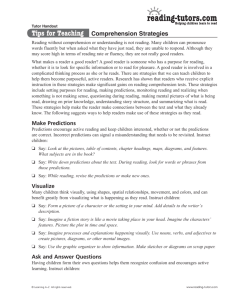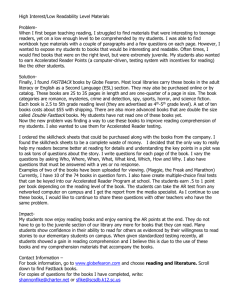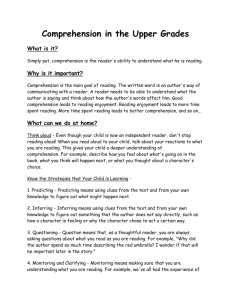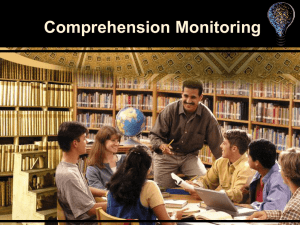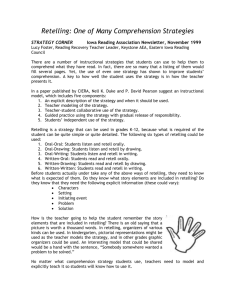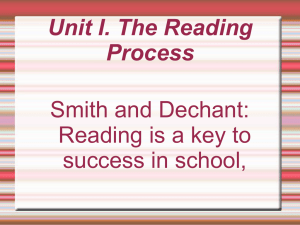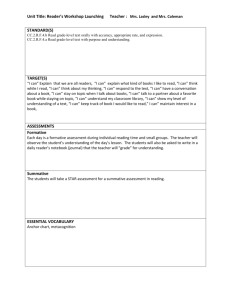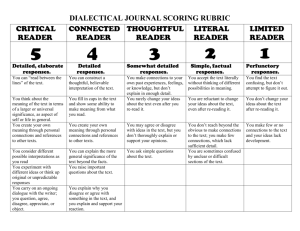Running Record Protocols
advertisement
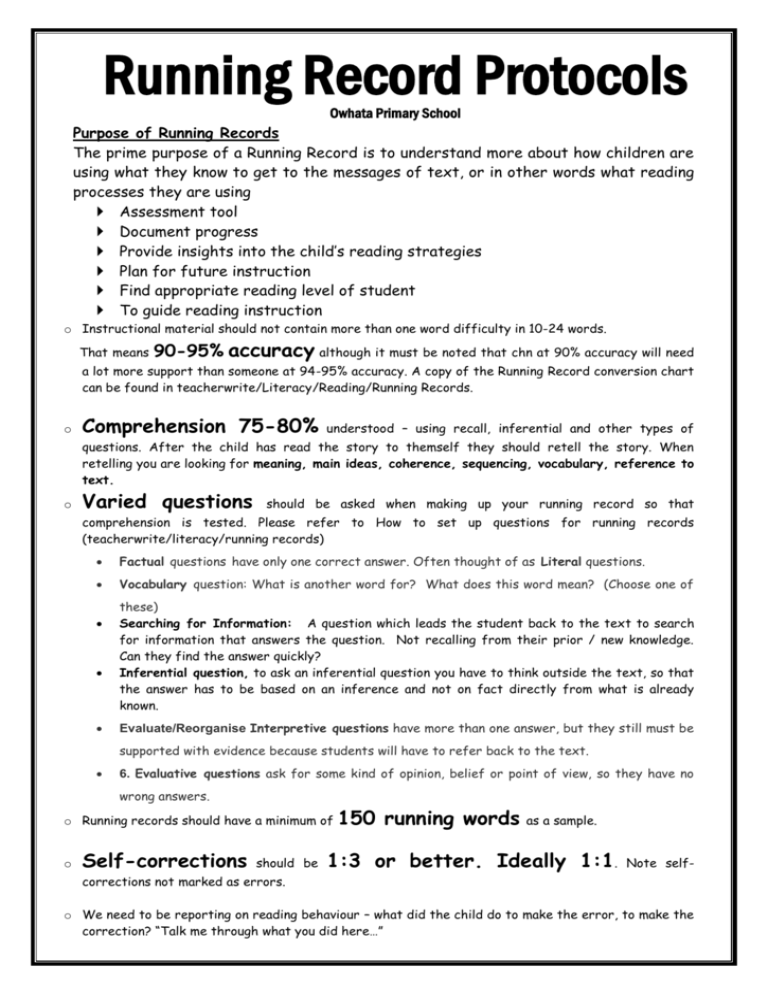
Running Record Protocols Owhata Primary School Purpose of Running Records The prime purpose of a Running Record is to understand more about how children are using what they know to get to the messages of text, or in other words what reading processes they are using Assessment tool Document progress Provide insights into the child’s reading strategies Plan for future instruction Find appropriate reading level of student To guide reading instruction o Instructional material should not contain more than one word difficulty in 10-24 words. That means 90-95% accuracy although it must be noted that chn at 90% accuracy will need a lot more support than someone at 94-95% accuracy. A copy of the Running Record conversion chart can be found in teacherwrite/Literacy/Reading/Running Records. o Comprehension 75-80% understood – using recall, inferential and other types of questions. After the child has read the story to themself they should retell the story. When retelling you are looking for meaning, main ideas, coherence, sequencing, vocabulary, reference to text. o Varied questions should be asked when making up your running record so that comprehension is tested. Please refer to How to set up questions for running records (teacherwrite/literacy/running records) Factual questions have only one correct answer. Often thought of as Literal questions. Vocabulary question: What is another word for? What does this word mean? (Choose one of these) Searching for Information: A question which leads the student back to the text to search for information that answers the question. Not recalling from their prior / new knowledge. Can they find the answer quickly? Inferential question, to ask an inferential question you have to think outside the text, so that the answer has to be based on an inference and not on fact directly from what is already known. Evaluate/Reorganise Interpretive questions have more than one answer, but they still must be supported with evidence because students will have to refer back to the text. 6. Evaluative questions ask for some kind of opinion, belief or point of view, so they have no wrong answers. o Running records should have a minimum of o Self-corrections should be 150 running words as a sample. 1:3 or better. Ideally 1:1. Note self- corrections not marked as errors. o We need to be reporting on reading behaviour – what did the child do to make the error, to make the correction? “Talk me through what you did here…” Analysis focuses on the cueing system the reader uses 3 cueing systems are: ◦ Meaning – semantic system – Does it make sense? ◦ Structure - syntactic system - Does it sound right? ◦ Visual – graphophonic system - Does it look right? First, the teacher analyzes each mistake according to M, S, or V – what influenced the error then the teacher interprets overall pattern of mistakes to evaluate child’s reading behaviors. Resources to Use for Assessment For the first 3 years of school running records must be done on a seen text. Seen text is where you have done planned sessions with that text. Running record should be done within a week of the instructional session. R2R for OTJ decision making and school data. From an 8 year reading age Probe is introduced for assessment to get a better gauge of comprehension with more abstract topics and unseen text. Running records can be done on the Journal stories etc chn are using in class. Coming soon, some development in Probe 2 and the use of Fiction/Non Fiction running records. Running Records - What Do They Tell Us? • Running Records capture what young readers said and did while reading continuous text • Judge what the reader already knows • What the reader attended to at difficulty • What the reader overlooked • Allows the teacher to describe how children are working with the text What is the reader doing or not doing? • Is the reader re-reading? • Is the reader self – monitoring? • Is the reader searching? • Is the reader waiting for a Told? • Is there evidence of re-reading to maintain the meaning of the story? • Is there evidence of fluent and phrased reading? • Is there a lot of, or a few self – corrections? What teaching move will you make? • Considering the analysis of the running record what book will you choose next? • How will you scaffold the learner in order to accelerate the learning? • What will be your focus for the next 5 lessons? o Reading Levels are to be given to Team Leaders in Week 3 on the Reading Profile Sheet (teacherwrite/achievementbooks/schoolrecordingsheets) NB: this does not mean a running record needs to have been taken on every child at this time (Please refer to the purpose of running records) but At Risk and Causing Concern children should be. In W4 of each term Year Groups meet and discuss collated results. These are then discussed at the management team meeting that week. Discussion Questions What patterns and trends does this data show about student achievement? (Focus on key sub groups within the cohort of students). What students are at risk or have special abilities? What is happening with the students who are moving? (What are we doing that is working? What strategies are the children using that means they are making progress?) What actions will be undertaken as a result of these findings? (Teacher approaches, professional learning for teachers, additional resources, follow up data investigation) Children are Causing Concern if they are 3-12 months below Chronological Age or Below National Standard (1 year below expectation). They are At risk if they are 12 months and over below C.A. or Well Below National Standard (more than 1 year below expectation). In Week 8 of each term, running record information is loaded onto assembly. o National Standards After 1 year at school at Green. After 2 years at Turquoise. After 3 years at school at Gold. At the end of Year 4 at Curriculum L2, At the end of Year 5 working towards Curriculum L3, At the end of Year 6 at L3 What might be gleaned from a running recording (Christine Jeffs – School Support Services 2009) General o Attitude? – confident, nervous, embarrassed, bored o Attitude to reading – is it a leisure time activity? What book is the child reading now? o Oral language skills – are they good enough to make the reading of this text possible, fluency maintained, phrasing evident? o Speed of responding – excessively slow, word by word, concerned about accuracy? Understanding o Can the child answer the conferencing questions (including inferential) satisfactorily? o Obvious interaction with text o Obvious searching to make sense of the text Word Attack o Has the child a method? – context, initial letter(s), picture cues (meaning), other? o Is there difficulty with initial sounds? o No obvious meaning input o No obvious grammar (syntax) input o Use of blend knowledge? o Use of syllabification? o Sight words – any problem? Self Correction Behaviours o Why is it taking place? Recognition does not make sense, sound right, look right o Any cross checking happening – what cues are being used for this? Directional Behaviour o No difficulties o Right to left e.g saw for was, not using initial sound o Loses place o Uses finger or marker (including voice) Some possible questions to follow a running record o Tell me what happened in the story o Why did ... act the way he/she/they did? o Why do you think.... o What was it in the text that led you that idea? o What do you think the author was trying to achieve when he/she ... o Tell me what you understand by the word ... e.g Scaffolding, flexible etc. Effective and Poor Comprehension Effective readers retellings will: o Be well organised with evidence of selection and reorganisation of relevant detail i.e. sequential. o Will typically contain the main points and/or the essence of the original text. o May be characterised by paraphrases that capture the original meanings using their own vocabulary. o Know that comprehension should be the end product of reading and will work actively towards that end o Will be aware when comprehension is not occurring and may use strategies to recapture the o meaning. Poor readers have difficulty using texts for a purpose because understanding is not their main purpose for reading (decoding is) It will be difficult for them to select what is important for their task and disregard the trivia. Poor readers may: o o o o o Give a list of unconnected items or events from the text. May lack coherence and focus. Show little evidence of paraphrasing. Show evidence of rote memorisation of words and phrases used in the original text, as if these readers have grabbed isolated bits of the text and tried to commit them to memory. Will probably not realise that comprehension is not occurring effectively. Ways children may retell: o An overview of the text. o Retell in sequence. o Give the main ideas from the passage. Consider: o Some children may not be familiar with silent reading and retell. o How much do you expect a child to retell from a first reading of a text? Imagine reading a newspaper article or editorial once and then retelling. This will give you an idea of what your expectations could be. o A child may read at over 97% accuracy but have failed to demonstrate any real understanding of the text in the retelling or in answering probe questions. This means the material is at a hard level. o The child may have ‘bumbled’ the running record but have demonstrated real understanding of the text. Consider if the child is in the consolidation stage of reading, try a different type of o o text to confirm your judgement, and consider whether you think they are ready to move onto another level. If a child is reading over the 8 year level fluently, but reads orally most of the time, they need to be encouraged to move into predominantly silent reading. If a child is at the consolidation stage, and a parent continues to make the child read out loud, they may well lose confidence because their oral reading is bumbling. Encourage parents to discuss the content of the text, rather than getting all the words correct. This also applies to the classroom programme. If the child has difficulty retelling after silent reading, but not after oral reading then a programme will need to be put in place to develop silent reading skills.

